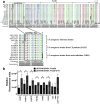A single point mutation in class III ribonucleotide reductase promoter renders Pseudomonas aeruginosa PAO1 inefficient for anaerobic growth and infection
- PMID: 29042684
- PMCID: PMC5645315
- DOI: 10.1038/s41598-017-14051-2
A single point mutation in class III ribonucleotide reductase promoter renders Pseudomonas aeruginosa PAO1 inefficient for anaerobic growth and infection
Abstract
Pseudomonas aeruginosa strain PAO1 has become the reference strain in many laboratories. One enzyme that is essential for its cell division is the ribonucleotide reductase (RNR) enzyme that supplies the deoxynucleotides required for DNA synthesis and repair. P. aeruginosa is one of the few microorganisms that encodes three different RNR classes (Ia, II and III) in its genome, enabling it to grow and adapt to diverse environmental conditions, including during infection. In this work, we demonstrate that a lack of RNR activity induces cell elongation in P. aeruginosa PAO1. Moreover, RNR gene expression during anaerobiosis differs among P. aeruginosa strains, with class III highly expressed in P. aeruginosa clinical isolates relative to the laboratory P. aeruginosa PAO1 strain. A single point mutation was identified in the P. aeruginosa PAO1 strain class III RNR promoter region that disrupts its anaerobic transcription by the Dnr regulator. An engineered strain that induces the class III RNR expression allows P. aeruginosa PAO1 anaerobic growth and increases its virulence to resemble that of clinical strains. Our results demonstrate that P. aeruginosa PAO1 is adapted to laboratory conditions and is not the best reference strain for anaerobic or infection studies.
Conflict of interest statement
The authors declare that they have no competing interests.
Figures




Similar articles
-
Function of the Pseudomonas aeruginosa NrdR Transcription Factor: Global Transcriptomic Analysis and Its Role on Ribonucleotide Reductase Gene Expression.PLoS One. 2015 Apr 24;10(4):e0123571. doi: 10.1371/journal.pone.0123571. eCollection 2015. PLoS One. 2015. PMID: 25909779 Free PMC article.
-
Vitamin B12-mediated restoration of defective anaerobic growth leads to reduced biofilm formation in Pseudomonas aeruginosa.Infect Immun. 2012 May;80(5):1639-49. doi: 10.1128/IAI.06161-11. Epub 2012 Feb 27. Infect Immun. 2012. PMID: 22371376 Free PMC article.
-
Analysis of transcription of the Staphylococcus aureus aerobic class Ib and anaerobic class III ribonucleotide reductase genes in response to oxygen.J Bacteriol. 2001 Dec;183(24):7260-72. doi: 10.1128/JB.183.24.7260-7272.2001. J Bacteriol. 2001. PMID: 11717286 Free PMC article.
-
Deoxyribonucleotide synthesis in anaerobic microorganisms: the class III ribonucleotide reductase.Prog Nucleic Acid Res Mol Biol. 2002;72:95-127. doi: 10.1016/s0079-6603(02)72068-0. Prog Nucleic Acid Res Mol Biol. 2002. PMID: 12206460 Review.
-
Pseudomonas aeruginosa reference strains PAO1 and PA14: A genomic, phenotypic, and therapeutic review.Front Microbiol. 2022 Oct 13;13:1023523. doi: 10.3389/fmicb.2022.1023523. eCollection 2022. Front Microbiol. 2022. PMID: 36312971 Free PMC article. Review.
Cited by
-
Detection of Known and Novel Small Proteins in Pseudomonas stutzeri Using a Combination of Bottom-Up and Digest-Free Proteomics and Proteogenomics.Anal Chem. 2023 Aug 15;95(32):11892-11900. doi: 10.1021/acs.analchem.3c00676. Epub 2023 Aug 3. Anal Chem. 2023. PMID: 37535005 Free PMC article.
-
A new BiofilmChip device for testing biofilm formation and antibiotic susceptibility.NPJ Biofilms Microbiomes. 2021 Aug 3;7(1):62. doi: 10.1038/s41522-021-00236-1. NPJ Biofilms Microbiomes. 2021. PMID: 34344902 Free PMC article.
-
The Small RNA ErsA Impacts the Anaerobic Metabolism of Pseudomonas aeruginosa Through Post-Transcriptional Modulation of the Master Regulator Anr.Front Microbiol. 2021 Aug 20;12:691608. doi: 10.3389/fmicb.2021.691608. eCollection 2021. Front Microbiol. 2021. PMID: 34759894 Free PMC article.
-
Characterization and Functional Analysis of a New Calcium/Calmodulin-Dependent Protein Kinase (CaMK1) in the Citrus Pathogenic Fungus Penicillium italicum.J Fungi (Basel). 2022 Jun 25;8(7):667. doi: 10.3390/jof8070667. J Fungi (Basel). 2022. PMID: 35887424 Free PMC article.
-
Optimal environmental and culture conditions allow the in vitro coexistence of Pseudomonas aeruginosa and Staphylococcus aureus in stable biofilms.Sci Rep. 2019 Nov 8;9(1):16284. doi: 10.1038/s41598-019-52726-0. Sci Rep. 2019. PMID: 31705015 Free PMC article.
References
Publication types
MeSH terms
Substances
LinkOut - more resources
Full Text Sources
Other Literature Sources
Molecular Biology Databases

